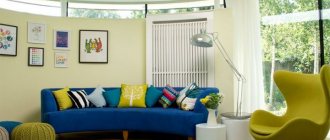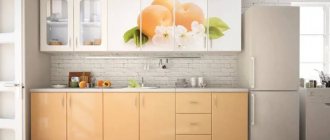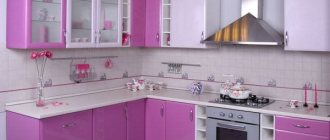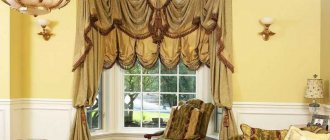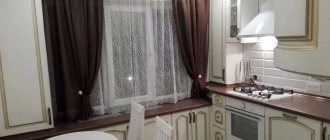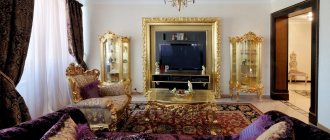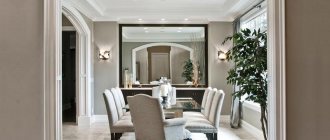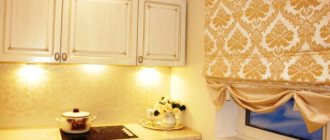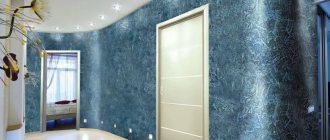Advantages of decorating kitchens in blue
Blue color is ideal for people watching their weight and wanting to lose weight. It is believed that under its influence the appetite becomes worse and we eat less. But even those who do not adhere to diets often choose it to decorate their kitchen, which is due to a number of reasons:
- A kitchen decorated in blue shades visually looks taller and wider. If you combine it with white, you can make it lighter. In combination, these colors make the room spacious, add lightness and air. While blue can weigh down objects and add bulk, its lighter counterpart has the opposite effect. Therefore, he is able to make even the smallest kitchen larger and more comfortable.
- Blue color has a beneficial effect on the human psyche. It promotes relaxation, gives a feeling of peace and tranquility. It is enough to remember the emotions that the blue sky or the surface of the sea evokes in us. A kitchen decorated in this color can evoke approximately the same sensations.
- Azure tones go well with other shades from neutral and light to bright and rich.
As for the disadvantages of this color scheme, you need to take into account that an excess of blue can provoke a feeling of fatigue and even depression. Therefore, it is recommended to dilute it with others.
IMPORTANT! This color scheme should not be used for a kitchen that is not located on the sunny side - it may turn out to be too cold. On the contrary, blue color is ideal if the windows face south or southeast - it will add pleasant coolness.
Combination of colors and contrasting shades
For the color design of the kitchen, you can use the following tones of blue:
- azure;
- sky blue;
- turquoise;
- cornflower;
- ultramarine and so on.
This color can be used both as a primary and as an additional color. If it is chosen as a base, choose lighter, softer and pastel shades. As an additional option, you can add bright variations of blue.
The color goes well with various shades. But since it is cold, it is better to complement it with warm colors such as beige, cream, yellow and so on. Combinations with white, gray, and brown shades look beautiful.
The combination of white and blue is a classic option that looks stylish and modern. It is recommended to choose it if you want to visually add space.
A combination of brown and blue is often used. It makes the room cozy and comfortable. As for the gray-blue kitchen interior , this is an option for those who want to combine bright notes with classic motifs in the design of the room. This option can also make the room feel more spacious.
Brighter and more unusual options are a combination of blue with yellow or green. In this case, it is important not to make the room too bright, so it is better to choose pastel color variations.
In addition to the fact that blue is combined with tones such as white, creamy beige, you can decorate the interior quite interestingly if you use it together with contrasting or bright shades.
Shades of green, such as mint, pistachio, and lime, help to refresh the coolness of blue.
The most daring and contrasting option is a combination of blue and red. Tones of red and orange will help balance the coolness of blue and make the interior stylish and bright.
How to use blue color in the kitchen interior
In fact, it serves both as a base and as accents. From the point of view of implementation, it has already become universal.
Base
As a base, designers choose gray-blue shades that do not get boring. This is how walls and floors are decorated, furniture and large accessories, such as a carpet, are selected.
In total, you get 60% of the main color in the space. You can complement the base with accents with prints in the same range: ceramic tiles on the apron or on the floor, curtains.
Addition
This is the most common solution. Additional color is considered to be color, which occupies about 30% of the interior. A blue kitchen set or dining room set is suitable for this. Moreover, when choosing the first one, pay attention to the different design options.
An idea to note: you can take combined cabinets rather than plain ones, for example, white top and blue bottom. The latter is supported by an accent wall in the same color scheme.
Accents
Here we are not talking about small accessories such as towels and small household appliances, but rather large stains. This is a bright apron surrounded by a neutral base, a stove, a refrigerator - the latter technique is not so common in the works of domestic designers, but is often found in the West.
Also, the tiles on the floor in any area and the dining room can become a stain. We do not recommend using gradual introduction of decor. One large spot of color, supported by small ones, looks much more harmonious in the interior. And not a lot of small ones, smeared around the room.
Furniture and appliances
As a rule, the decoration determines the decoration of the room. A blue kitchen goes perfectly with a wooden countertop, although a plain white or gray one, including an imitation stone one, would work just as well.
Leading manufacturers do not limit themselves to the usual range, so finding the right color will not be very difficult. For a blue kitchen set, it is recommended to select a dining set in white, beige, and brown colors.
The glossy surface reflects light well and visually expands the space. The matte surface looks impressive, but requires specific care. The texture is preferably smooth, since all kinds of inserts and decorations will accumulate dirt and take more time to clean.
If blue is already more than enough, when choosing household appliances for the kitchen you should start from the usual design. If, on the contrary, you need to add a few accents, you can choose small household appliances in the desired shade, such as a kettle and a juicer.
Preferred interior colors
There are many surfaces in the kitchen that can be painted. Another question is which ones to make blue, and which ones to use other colors. Each decision can lead to a different effect.
The main color is used for the ceiling and walls. With their help, a general background is created. It is worth understanding in detail where and how to apply blue shades.
Floor
The flooring in the kitchen is designed to set off the main background. This largely depends on the qualities and properties of the materials.
Laminate and parquet in the kitchen look great, but are not practical flooring. They can be used for the dining area. It is better to use other coatings under the sink, stove and refrigerator.
- Tiles - ceramic, vinyl (very practical and non-slippery), porcelain stoneware. The coating is easy to clean and does not absorb odors. Depending on the stylistic direction of the blue kitchen design, matte and shiny surfaces are selected. This is an excellent material for those who like to lay out intricate patterns and ornaments.
- Linoleum is a budget option for all times. It lasts less, but there is always the opportunity to update the interior depending on fashion trends. The main advantage of the material is the ability to make the floor perfectly flat, smooth and shiny.
- Self-leveling flooring is an excellent alternative to tiles. It is also called “liquid linoleum”. The result is an absolutely flat surface without joints or seams. Housewives claim that cleaning and washing such a surface is a pleasure.
If you want to lay carpet, you need to be prepared for constant dirt. If greasy stains appear (and this is an essential element for the kitchen), the coating will quickly lose its presentable appearance. It will be very difficult to clean it.
Walls
Using the walls and ceiling, the basis for the blue background is created. They are usually painted white, but variations are possible. The main task is to choose a suitable palette and high-quality finishing materials. For wall cladding in the kitchen, the following construction positions are used:
- paint is a simple and affordable option; after painting, it is possible to print any design/pattern/ornament using a stencil (by the way, stenciling or 3D wall printing has recently become fashionable. There are companies that provide similar services);
- wallpaper - it is better to purchase non-woven or glass wallpaper, they will last a long time, wash and clean well;
- decorative plaster - with its help, an accent wall stands out, for example, in the dining area. Its relief depends on the thematic focus of the design. For example, a wave-like texture will bring owners back to the sunny seashore;
- panels - it is not recommended to be used everywhere, since the coating quickly fails, but its use for hidden storage systems remains relevant.
It is advisable to cover the walls in the area of the work area (sink, countertop, hood, stove) with ceramic tiles. This is a durable material that is resistant to temperature changes and high humidity.
Ceiling
The ceiling can also be made of different materials:
- Tension made of polyvinyl chloride. This ceiling is bright, glossy, beautiful, but it interferes with the exchange of humidity in the room and can be ruined with one awkward movement - it breaks very easily. It looks good exclusively in modern styles, because during the formation of styles, classic glossy ceilings did not exist in principle. Requires mandatory hiring of professional workers.
- Tension made of fabric. It does not tear and allows moisture to pass through, but it is heavier and will most likely have seams. It looks interesting, you can put a painting on it - thanks to the texture, such a ceiling depicting the sky with clouds will look very impressive.
- Plaster. Classic. It also looks convex, interesting, it’s very easy to make patterns on it, it doesn’t get damp and lasts a long time.
- Drywall. Allows you to create several levels on the ceiling, which is very useful for zoning. It will have a beautiful uniform color, plus it is very difficult to ruin. But to attach it, you will most likely have to hire professional workers.
- Dye. The easiest way is to apply it yourself, if you act precisely and carefully, otherwise there will definitely be drips. It looks unpretentious and simple, and is not suitable for all styles.
There are also plastic panels, but they have a very specific appearance and are most often used in non-residential premises, because they are flammable and emit a specific unpleasant odor.
Tip: Also choose the ceiling based on your style.
Combinations
It is important not only to choose a practical, beautiful blue material for decoration - it is also important to combine it with the rest so that it looks good. First of all, the color of the material plays a role, since the properties of everything that can be used in the kitchen are more or less similar.
Small kitchen design
The combination depends on the characteristics of the kitchen:
- If the kitchen is frankly small. In this case, the blue color can be a real salvation, and in order to visually expand the space, you need to choose its lightest shades - from a slightly darker floor to a completely transparent, weightless ceiling. Mirrors, photo wallpapers with a sea view, a glossy surface of the floor and ceiling may come in handy - of course, not all at once, but one or the other.
- If the kitchen is frankly large. This happens when the room is larger than necessary in order to feel comfortable. In this case, dark shades of blue in combination with bright accents are suitable - they will make the kitchen smaller and slightly move the walls. However, it is very important not to overdo it, not to use too dark a color and not to forget about a bright accent, otherwise the impression may turn out gloomy.
Chic light blue kitchen
- If the kitchen is too high. When you enter such a room, it seems that you have entered a St. Petersburg courtyard-well. To avoid this, you need to make the ceiling darker than everything else. This could be a shade of blue or a contrasting color - the main thing is to give the impression that the ceiling is lower than it actually is.
- If the kitchen is too low. Then the ceiling, on the contrary, should be light, and everything else should be darker. Vertical stripes will look good - they will make the walls seem taller.
- If the kitchen is too narrow. In this case, you can do different things. Lay a covering with a diagonal pattern on the floor, make photo wallpaper on one of the walls, use the lightest shades of blue. You can highlight one wall - most often the one at the end - so that it attracts attention and seems that it is closer than it actually is. To do this, you can use a contrasting color - yellow or orange. Although a colorful finish in the spirit of intricate painting is also suitable.
- If the kitchen is too wide. Then the walls become darker, and the floor and ceiling become lighter. As a result, it seems to be stretched upward.
For a wide kitchen it is better to make light walls and ceiling
Finishing is a difficult task, but if you approach it with patience and imagination, the result will be amazing.
Tip: Instead of selecting materials yourself, use a ready-made style and then you will be sure that the result will be good.
Finishing
The classics are taken as a basis. Such repairs will not have to be redone if the unusual colors suddenly become boring or tiresome, but you can always create the desired mood in the decoration.
A white ceiling is a universal solution. A matte canvas is preferable, but for the purpose of visual enlargement, a glossy stretch ceiling is allowed. The floor covering must be non-marking and durable.
A colored ceiling and/or floor is an experiment fraught with risk. Without having design skills, you can miscalculate the balance.
The walls can merge with the furniture, creating a single composition, or be of a completely different color, usually light. Area and illumination are taken into account.
Blue wallpaper (with or without print) and a white set are a folding tandem in the kitchen. You can decorate only a fragment of a wall or just one accent wall in color. Tiles, tiles, washable wallpaper, and Venetian plaster are easy to maintain.
The part of the wall between the countertop and wall cabinets, called the apron, deserves special consideration.
The arrangement of this zone performs not only a protective function, reliably protecting the wall from the influence of factors arising during cooking, but also a decorative one, taking into account the variety of possible materials, textures and designs.
In a white kitchen, it is important to use acrylic glass in blue or ceramics in the majolica style, combining several similar colors. Light ceramics with different effects will suit the azure set.
Matching Styles
If you talk about what materials there are, you can do without a clear connection to style, but in the case of furniture you can’t do without it. There are too many kitchen sets, dining nooks and decorative items to be able to first explain what they are, and then choose something suitable from the variety.
Blue color looks good in both classic and modern interior styles.
Scandinavian style
Scandinavian-style kitchens always strive for white. It is considered the main one and dominates the decoration of walls, ceilings and floors. Furniture supports this trend and chooses white or light gray tones, but you can also decorate the set in blue.
Natural tones are best suited for this. For example, a calm color scheme of cold tones, reminiscent of an ocean wave or dull glaze. It is worth choosing accessories to match, for example, dishes, a picture, or at least a photo frame.
Classic
This is a style that was formed in Europe back in the eighteenth century and was especially popular in France:
- Floor. Only and exclusively tiles - the classics do not recognize any other materials. Moreover, cheap varieties can be immediately crossed out from consideration; these should be expensive painted or patterned tiles, beautiful in themselves.
- Ceiling. Of course, it would be strange to support it with columns in a modern apartment, but stucco molding and different levels may well take place. If this seems too pompous to you, you can make a subtle floral pattern along the edge of the ceiling - elegant and not too noticeable.
- Walls. Natural materials in calm shades. Nothing flashy, and, of course, no plastic panels.
- Furniture. Classic, made of real wood. There is no special pomp, the only thing that is acceptable as decoration is carving.
- Lighting. The windows have fabric curtains of a dark shade. Under the ceiling is a small, elegant chandelier, possibly forged. There must be a lamp with a lampshade on the table.
- Decor. Textiles are moderate, without emphasis. The trinkets are extremely expensive, with a pretense of historicity. Painted plates, cups, a couple of figurines somewhere on the shelves, beautiful cutlery, an elegant teapot that needs to be heated on the stove will work well.
Classic is beautiful. There are no particularly bright accents; blue can be combined with white, beige and real wood colors.
Advice: Classics require a certain conservatism. It is better not to display technical appliances - such as a coffee maker or a steamer - in a visible place.
Mediterranean
The name of the style itself already conveys its basic color scheme - shades of blue, blue, sea wave, turquoise, azure. The background is white, light gray, and the accents are yellow, orange and red.
Minimalism
This design direction prefers to avoid unnecessary things. This applies not only to decor or furniture, but also to the color scheme - only 1-2 tones are used.
A blue set with glossy surfaces and strict geometric shapes will fit into such an interior. But the color range is wide - from aquamarine to indigo and eggplant.
High tech
This style really likes to use space as technologically as possible, so this is where you can find the latest technologies, built-in appliances that combine a large number of different functions.
Bright colors are used as rationally as possible and at the same time limited. In blue you can do:
- headset;
- one wall;
- ceiling;
- niche.
But this is rather an exception to the rule, since high-tech does not really like bright spots in the interior.
Loft
A typical loft-style kitchen looks like this: a large area with high concrete walls and huge windows, protruding pipes and an exposed air duct. Blue in such an interior can only be used as an accent if it is important to attract the attention of those entering.
For example it could be:
- gray-blue wall or section of floor;
- dark blue buffet or cabinet.
It is also important to ensure that the color matches the brick and metal, so blue paint with a metallic effect will look impressive. It can be used to cover decorative elements - chair legs, lamps or the same pipes.
A bright blue retro refrigerator will also look creative. Stylistically, it can be supported by old posters on the walls and an antique sofa with a sleeping place - a very interesting solution.
Modern style
The set is made in blue, its shape is strict and straight. The appliances selected are built-in and modern; their shiny surface reflects light, making the space more spacious.
You can complement the interior with other colors, but you should avoid excesses in colors and decor. In a kitchen in contemporary style, only the most necessary items are left, among which there should be order. Blue is chosen in tone closer to gray or cyan.
Country
The main task of a country style kitchen is to create a warm and cozy atmosphere. Blue goes well with wooden surfaces, so it is better to use them equally.
The interior will be complemented by cute little things like small rugs, painted dishes and a patterned tablecloth. The lighting must be warm so that the level of comfort and coziness is maximum.
Sea breeze
In a nautical style, the best color combination is white and blue - wooden surfaces are also added to them.
Usually the set is left blue and the trim white. Textiles with marine patterns and themed items will help complement the interior.
Fusion
There is no single concept for this style, because fusion is eclecticism, so you can only be guided by the rules of color combinations.
For example, to create a bright, unusual kitchen, you can take a standard blue and white combination and generously flavor it with bright spots of yellow, red, pistachio, and so on. If you are afraid of going overboard, you should add more neutral tones to the interior, for example, beige.
Provence
This is seventeenth century France - a counterpoint to the bulky styles of the time. The main property of Provence is airiness and lightness, to which the blue color fits just perfectly:
- Floor. The tile, and by no means smooth, is extremely rough; you can even age it artificially to make it look like natural stone. There are no patterns on it, but you can lay a small carpet.
- Walls. Natural materials - wallpaper, lining, natural stone finishing. Floral patterns are allowed, which will not burden the interior, but will make it more interesting.
- Ceiling. No suspended ceilings or drywall. Exclusively paint or plaster, plus wooden beams - it’s good if they’re real, but a high-quality imitation is also possible. Everything together should give the feeling of a country house.
Provence style
- Finishing nuances. Doors should be made of light wood, preferably with traces of time that can be applied artificially. The bigger the windows, the better (but not panoramic ones), preferably with snow-white wooden frames.
- Furniture. Definitely classic shape, light. The material used is wood, which can be painted or with carved patterns. A good solution would be to install wicker chairs and armchairs, perhaps with blue cushions on the seats to make it more comfortable.
- Lighting. Natural is emphasized, the curtain is made of light fabrics, perhaps in a cafe style, where half of the window remains open at all times. Artificial - imitating candles or small lamps under bright lampshades. The light should be yellowish, warm, diffused and very cozy.
- Decor. In Provence you can’t do without cute little accessories. There must be a vase with fresh flowers on the table (it can become a beautiful accent in a blue kitchen, since pink and scarlet go well with it), and ceramic pots with flowers on the windowsill. Spices in special glass jars, each with a paper tag faded from time to time. The birdcage will fit in like a home – forged, antique in appearance.
Styles
The range under consideration is more or less compatible with all current trends:
- Rustic. A blue kitchen in country and especially Provence styles is ideal in the space of country houses. Creates a special mood in city housing. The main thing to remember is simplicity and restraint.
- Mediterranean. Associated with freshness and lightness. These properties of the palette in question were discussed above.
- Scandinavian. Blue and white together create the very naturalness that forms the basis of the style.
- Modern, high-tech, minimalism. Today's trends welcome non-standard solutions. The coldness of blue corresponds to the desire for minimalist design.
- Classic and shabby chic. Variegation is not typical, but light shades fit well.
In all cases, we are talking primarily about furniture, textiles, and decorative elements. Walls, ceilings or floors should be decorated in a similar color scheme very carefully so as not to oversaturate the room.
What colors go with blue
A blue kitchen in the interior looks different not only because of the main shade, but also due to additional ones. Next, we’ll find out what to combine blue with to get the perfect picture.
Beige
Kitchens in blue tones can look too cold, especially if the windows face west or north. To avoid a lethargic mood in the design, dilute the base with a warm neutral shade.
Despite the difference, beige goes well with pale blue, neutralizing its negative characteristics.
The photo shows beige shades in furniture and appliances
White
The combination of blue and white is the most classic possible. It is quite contrasting and fresh, so it will be an excellent option for a blue-colored southern kitchen. There will be a lot of light in the room, but at the same time the desired coolness will remain.
Brown
Brown can also complement and “warm up” the blue palette, especially if it is wooden furniture and flooring.
Black
A blue and white kitchen with black accents is a bold and unconventional solution, especially popular in Scandinavian-style interior design.
Black and blue colors in the interior of a kitchen in Provence style
Grey
To prevent the gray-blue kitchen from seeming too cold and gloomy, complement the interior with warm shades, an abundance of white and wooden furniture.
The ash-gray combination looks strict and restrained; the contrast of the combination is much lower than that of the symbiosis with white. To make gray-blue kitchens look harmonious, follow the rule: the lighter the blue, the darker the gray should be.
Red
This contrasting color combination is not often used in kitchen design, but it can be quite harmonious, especially if it is pink-red or orange-red.
Pink
Pink paired with blue can create a different mood depending on the shade. If you use bright pink paints, the kitchen design will become more dynamic and emotional; if you use a soft pink shade, then it will be restrained and too calm.
Therefore, you can use the following combinations: hot pink + baby blue, baby pink + turquoise, baby pink + baby blue + yellow or orange (invigorating colors), baby blue + hot pink + beige (balancing color) etc.
Several examples of such combinations are in the following photo slider.
Yellow
It is believed that yellow is the opposite color to blue and cyan, which means it is complementary and especially suitable for it. In fact, the opposite of blue is orange, but yellow goes well with blue just as well.
The cheerfulness and warmth of yellow more than compensates for the coldness and poise of our hero, so this pair is appropriate in any kitchen - be it northern or southern, but if you want to simulate a calm atmosphere in the kitchen, then use yellow in muted, pale, delicate colors, or in small quantity.
Blue
The blue color is obtained from blue, which has been diluted with white paint. In proximity to blue, blue becomes softer, a play of colors is created, and the effect of freshness and coolness is enhanced, so it is better to avoid such a combination in the design of a “northern” kitchen.
A monochrome kitchen in blue tones is not suitable for everyone: an abundance of blue can have too much of an impact on the nervous system and cause apathy. But if you are constantly stressed and need maximum relaxation at home, then this combination will work to your advantage.
Green
Blue and green are close neighbors in the spectrum, so they harmonize perfectly with each other. Since in nature this union of colors is most often represented by plants (these are cornflowers and bells in the grass, hyacinths with their delicate stems, algae in sea water, tree crowns against the background of the same sky), natural plant shades will be most successful when paired with blue .
Light wood
The most used kitchen design in beige and blue tones is to use light wood surfaces. Bleached oak, ash, and pine look gorgeous in interiors from classic to loft.
Color characteristics
To successfully incorporate blue color into your kitchen interior, you need to know its properties.
- Impact on the mental and physical state: blue, like green, is a short-wave color, that is, our eyes rest on it. It also has a calming effect at the same time: it reduces appetite, reduces blood pressure, has a beneficial effect on mood and the nervous system, and, at the same time, promotes concentration and develops creative thinking. From these properties it follows that the blue interior is especially suitable for people who watch their diet, hot-tempered, impulsive and overly emotional people, as well as people with hypertension.
- Blue interior is especially recommended for: well-lit kitchens with windows facing south, as well as for decorating small and narrow kitchens.
- Interaction with space: blue, unlike blue, does not “weight down” objects and does not “eat up” space, but on the contrary, it enlarges and expands it, therefore almost all variations of blue can be used in large quantities, for example, in the design of walls, large furniture, for example , headset and even floor and ceiling as shown in the photo below (scroll through).
- Interaction with other colors: blue shades are found in nature in very large quantities, because these are the colors of the sky and water, and therefore they are combined with almost all the colors of the rainbow, and especially with their neighbors in the spectrum - green and blue, with opposites - orange and yellow, as well as with achromatic colors - white, gray and black.
- Matching styles: a kitchen in blue tones can be decorated in any style, but styles are especially organic: classic, Provence, country, shabby chic, Mediterranean, maritime, Spanish, Scandinavian.
Curtains for a blue kitchen
Blue curtains will be a real lifesaver in cases where you want to add bright colors to the kitchen, but there is a fear of going overboard, for example, in a white kitchen.
If the window is small or standard, then you should take a closer look at light, flowing fabrics that can let light through. The only exception is the sunny side: it needs dense material that could save the room from the sweltering heat.
As for fabrics, it is better to take a closer look at mixed options, as they are considered the most practical, but linen or organza will also work. As for the types of curtains, you can limit yourself to ordinary curtains, Roman or roller blinds, or blinds.
Gray-blue kitchen in the interior
The combination of gray and blue is considered classic. But an excess of cold colors makes one feel despondent and melancholy. Only well-lit rooms should be decorated in blue and gray, otherwise the room will be too dark and uncomfortable. The combination is often found when decorating an American-style or high-tech kitchen. At the same time, light gray tones are used as a basis; walls are decorated with them, and furniture and accessories are used in blue.
If blue prevails, then gray is used for accessories: furniture fittings, curtains, towels, serving items.
Decor elements
Blue, as a dominant color, encourages the use of metal products, be it in appliances, lighting fixtures or decorative items.
As an accent, it can be present in the dishes used, designer wall clocks, panels and other things in the kitchen interior. A bouquet of cornflowers or a houseplant would be a great addition.
Decor options
If the overall design of the kitchen is made in blue tones, then bright elements of orange, yellow, red, green, and blue can be used as decor. This could be a tablecloth, flowerpot, painting, vase, chair cushions or napkins for cutlery.
Decorative elements of a blue hue will also help to dilute the monochrome interior, introducing color variety into it.
An interior that is too bright, for example, with a predominance of yellow, can be balanced by blue, bringing calm and rigor.
House plants can be the finishing touch to the design. Green leaves will harmonize with the overall color scheme and enliven the atmosphere.
Blue kitchen appliances
Against the background of blue facades, built-in white, gray, black and metallic appliances will look beautiful.
In retro-style interiors, bright red and orange vintage refrigerators and freestanding stoves with an oven look interesting.
You can go the opposite way and decorate the appliances, rather than the facades, in this color. The retro refrigerator and stoves in a delicate shade of the sky look very original in the interior.
White and blue kitchen
The combination of these colors is one of the most natural, natural. Light colors push the boundaries of space, and small kitchens look cozy and free.
Traditionally, blinds and ceilings are decorated in white. In addition, it can be used for finishing:
- kitchen set;
- household appliances (refrigerator, dishwasher);
- apron;
- furniture: table tops, upholstery on chairs.
The combination of white and blue is universal and is found in all styles from country to high-tech. However, it looks most organic when there are references to folk motifs: Gzhel, porcelain painting.
White can dominate in the kitchen, and blue can only be used for accessories Source house-biz.ru
White accessories will look harmonious in a blue kitchen: textiles (towels, tablecloth), dishes, decorative elements (vases, figurines, figurines).
Combining colors allows you to divide the kitchen into zones. For example, the furniture and cooking area are in blue, the dining room is in gray.
Colors help to zone a room no worse than the furniture itself Source happymodern.ru
Kitchen set
A blue set will definitely attract all the attention in the kitchen, so it is better not to duplicate this tone in the room or choose very small decorative items to match the tone, for example, a vase or dishes. Antique metal handles look best on such furniture, for example, from:
- bronze;
- become;
- copper
Chrome or nickel plated surfaces are also suitable. Not everyone will decide to buy a completely blue set, so there are also analogues on the market - for example, a white or beige top and a blue bottom.
It is important to think about the apron - it should be combined with the blue kitchen. The following tones are perfect for this:
- grey;
- white;
- cream;
- brown;
- yellowish.
It is worth paying attention to the material from which the set is made. The options are completely different.
Tabletop and apron
Another design option in blue is the work area. This can be a separate apron or tabletop, or both items at once.
In any case, the work area should be in harmony with the rest of the room’s decoration - walls, ceiling, floor, and kitchen unit. Since the work area does not take up as much space as the set, its blue tone can be duplicated in curtains or a dining area.
Often the countertop and apron are made of the same material. This creates a very harmonious atmosphere, especially with a corner layout.
The classic combination of a white kitchen and a blue countertop. Pay attention to the fittings and small inserts in the apron
Materials for the blue work area
The blue color greatly limits the number of materials suitable for finishing the work area. For example, first of all you will have to abandon natural and artificial stone, as well as untreated solids. But there are still many options to choose from.
| MDF and chipboard | These panels are wood chips, just processed differently. In this regard, these options cannot be called durable. In addition, due to contact with water, they can swell, so such surfaces should be treated very carefully. |
| Ceramics | Ceramics have long since taken root on an apron, and on a countertop it will look very original. This is an excellent material - resistant to moisture and temperature. The only negative is the seams. They will become clogged with grease, dust and dirt, and over time, fungus may even appear. |
| Steel | A very practical material - durable, easy to care for and resistant to high temperatures, water and chemicals. It’s not for nothing that restaurant kitchens use steel for everything. But the kitchen in the apartment is not a service space, and the style of steel is very difficult to fit into the interior. Most often, comfort disappears instantly. |
| Strained glass | Another practical option - it does not absorb dirt and grease, and is not afraid of water and temperature. It is more suitable for an apron (more details in this article), since it is afraid of strong impacts and falls. But there are also glass countertops. |
Notice how beautiful it looks, not the typical white boar, but the blue one. Epoxy grout will keep the seams in their original condition for a long time
Wooden kitchen
Wood in the interior refers us to naturalness and nature. There are several options for introducing it into a blue kitchen: make a wooden apron and countertop, or choose facades with a wood texture.
This option will give the interior status and high cost. Photo: shutterstock
The first option will add coziness and warmth to the space, and the second will give the interior status and high cost.
Wood in the interior is an eternally fashionable trend. Photo: globallookpress
Matte kitchen
The matte smooth surface of the facades looks ultra-modern and does not require special care. But due to the lack of a “reflection” effect, such a set visually narrows the space.
This combination is very lively and rich. Photo: pexels/Houzlook
To level this out, you can make only the bottom row of cabinets matte, and for the top row choose facades made of glass or with a slight sheen. Another way to lighten the design is to paint the furniture in the color of the walls so that they merge as much as possible into a single whole.
Glossy kitchen
Due to the play of light, the blue gloss of furniture facades visually increases the area of any kitchen. But this coating has one obvious drawback - it requires special care. Since glossy furniture requires constant cleaning of dust, stains and fingerprints, most people refuse it. The marks are especially noticeable on facades of bright and dark colors.
The noble appearance gives the kitchen a sophisticated atmosphere. Photo: shutterstock
Gray-blue tone in the kitchen
Gray and blue create a universal combination. You can use 2-3 options for using this palette:
- Decorating the room. The walls are painted blue, sometimes reminiscent of a hospital and create an appearance of sterility in the decoration. Therefore, shades of gray are often chosen as the basis for the kitchen - from dark to almost whitish tones. Here blue should be used as accents: for example, decorate a wall with embossed wallpaper. Depending on the style, the print is selected according to the theme: flora, geometry, animalism and various abstractions. What color the floor should be – black or light – depends on the type of lighting and the selected palette. In apartments, wood is often used, and in individual houses, where the square footage is large, dark wood or tiles are used;
- Kitchen corner - a simple look is a one-color, classic direction. Blue kitchen sets with stone countertops or wooden ones with accents look attractive. Combined facades are a fashionable technique. You can arrange a sky-colored bottom and a gray top. You can also decorate them with colored inserts, creating verticals, thereby highlighting the cabinets located along the edges or the built-in refrigerator. The backsplash can be created using accent trim. The blue and white tiles are reminiscent of Portuguese azulejos. This option with a similar motif will suit modern decoration. If this solution is not to your liking, then single-color tiles for the apron will be suitable in any case;
- Furniture – an unusual technique is chairs with an accent color. Upholstered furniture, cabinet furniture and also stools will fit well. To go with the loft style for a gray-blue kitchen, you need to take Tolix metal chairs. Furniture with thin legs is well suited for tight spaces. Where there is a large area, you can choose dimensional models, which seem to be an average version of a chair with an armchair. You can support the accent with objects, decorations and textiles. If you do not repeat shades, then the kitchen furniture will look like a bright spot in the color palette of the entire design;
- Availability of equipment. A brave decision would be to purchase colored equipment. For example, an electric stove or refrigerator. Such an application will require an appropriate background, so white is selected for the base. Gray can be used in elements, for example, in marble and textiles.
Features of blue kitchen lighting
With improperly organized lighting, a kitchen in blue tones in the evening risks turning into gloomy and uncomfortable. Cool shades need good artificial lighting more than others. To do this, it is important to provide not only central lighting, but also illumination of the work area and local lighting of the dining area.
For artificial lighting, choose warm light.
Choosing a kitchen style
The blue kitchen is an island of calm and comfort in the home. There is always a pleasant and slightly relaxing atmosphere here. In order for cooking or evening tea, for which the whole family gathers, to take place in an even more pleasant environment, you need to decide on the style of kitchen design. This will help you organize the space correctly and harmoniously select elements: furniture, decoration, accessories.
Shades of blue look organically in different styles: Provence, Greek, Scandinavian, marine, classic, American. Here this color is the main one.
It is used on walls, ceilings and floors and in the design of furniture facades. Pastel colors are used as the main color. White and blue kitchens have long become classics in these styles.
The soft blue color goes perfectly with the carved and curved details of the furniture Source kuhnov.ru Even a small kitchen with the right choice of style and color looks cozy Source rosdrev.ru
Country, high-tech, shabby chic, modern also often turn to this color. Here, individual elements are decorated in blue: tables or chairs, curtains or a kitchen apron; sometimes rich shades are used to focus attention on individual details. Any style is characterized by the use of light colors.
Photo of a blue kitchen
Sources
- https://dizainkyhni.com/dizajn-kuhni/golubaya-kuxnya.html
- https://www.ivd.ru/dizajn-i-dekor/kuhna/svezho-i-neobychno-vsyo-o-tom-kak-oformit-golubuyu-kuhnyu-66681
- https://ArtyHomes.ru/golubaya-kuhnya/
- https://modernplace.ru/kuhnya-v-golubyh-tonah/
- https://remontkit.ru/dizajn/sinjaja-kukhnja.html
- https://onkuhnya.ru/dizain/golubaya-kuhnya/
- https://design-homes.ru/komnaty/kukhnya-i-stolovaya/golubaya-kukhnya
- https://kitchendecorium.ru/design/color/goluboj-cvet-v-interere-kuxni.html
- https://minikuhonka.ru/%D0%B3%D0%BE%D0%BB%D1%83%D0%B1%D0%B0%D1%8F-%D0%BA%D1%83%D1%85% D0%BD%D1%8F-70-%D0%BB%D1%83%D1%87%D1%88%D0%B8%D1%85-%D1%84%D0%BE%D1%82%D0% BE-%D0%BF%D1%80%D0%BE%D0%B5%D0%BA%D1%82%D0%BE%D0%B2/
- https://gidintererov.ru/golubaya-kuhnya
- https://www.kuban.kp.ru/expert/dom/dizajn-goluboj-kukhni/
- https://kuhnidizajn.ru/golubaya-kuxnya/
Blue color in various interior styles
The style direction of the kitchen is a matter of taste. Blue color looks advantageous in different interiors, provided there is balance in all details. Let's look at the most successful and popular options.
Modern
A deep and rich blue color suits strict minimalism , cosmic high-tech , and multi-level asymmetrical modernism . Such kitchens are distinguished by the absence of pretentiousness, chrome fittings and accessories, mirror-like shine of facades and shimmering blue metallic.
Classic
A restrained classic kitchen in matte, muted tones is distinguished by the strict lines of the facades and the cold shine of the metal frame. It is better to “dilute” the interior with the warmth of furniture and fittings made of natural wood.
Country flavor
Multifaceted country style. This kitchen is characterized by muted natural shades of blue (azure, turquoise, cornflower blue, sea green) in combination with antique wooden furniture, finishing stone, mosaics, fabrics and handmade accessories.
Nautical
One of the most peaceful styles, containing echoes of country and Mediterranean trends in interior design. Its main feature is the combination of cold blue shades (azure, sea wave, turquoise) with sandy yellow, terracotta and various undertones of white (milky, the color of baked milk). Nautical-themed illustrations and accessories enhance associations with the beach, lounge or beach house.
Laconic Scandinavia
This style is recognizable by natural materials, restraint, noble pallor and cold blue shades. But at the same time, coziness and comfort will reign in the room. The best option for such a kitchen is a delicate blue set combined with white furniture. Modern interiors use a deep blue-gray color, diluting its monotony with bright accessories and large lamps with warm light.
A spacious kitchen in blue looks harmonious in Empire , Provence or Art Deco , which imply an abundance of textiles, expensive elegant decor and luxurious furniture. For a modest one, marine or Scandinavian themes are suitable, visually expanding the space.
